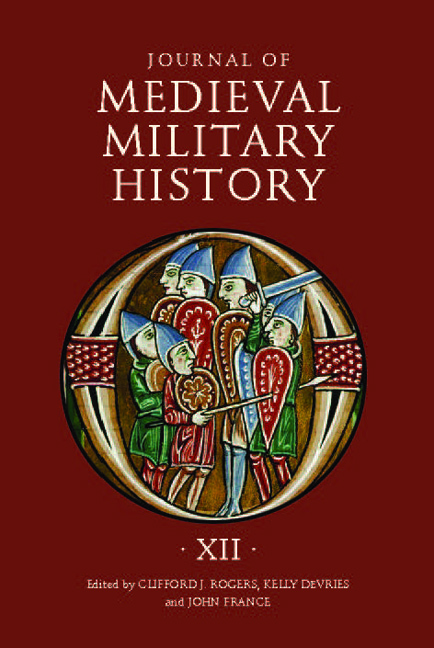Book contents
- Frontmatter
- Contents
- List of Illustrations and Map
- 1 Some Observations Regarding Barbarian Military Demography: Geiseric's Census of 429 and Its Implications
- 2 War Words and Battle Spears: The kesja and kesjulag in Old Norse Literature
- 3 The Political and Military Agency of Ecclesiastical Leaders in Anglo-Norman England: 1066–1154
- 4 Couched Lance and Mounted Shock Combat in the East: The Georgian Experience
- 5 The Battle of Arsur: A Short-Lived Victory
- 6 Prelude to Kephissos (1311): An Analysis of the Battle of Apros (1305)
- 7 Horse Restoration (Restaurum Equorum) in the Army of Henry of Grosmont, 1345: A Benefit of Military Service in the Hundred Years' War
- 8 The Indenture between Edward III and the Black Prince for the Prince's Expedition to Gascony, 10 July 1355
- 9 Investigating the Socio-Economic Origins of English Archers in the Second Half of the Fourteenth Century
- 10 War and the Great Schism: Military Factors Determining Allegiances in Iberai
- List of Contributors
- Journal of Medieval Military History 1477–545X
2 - War Words and Battle Spears: The kesja and kesjulag in Old Norse Literature
Published online by Cambridge University Press: 05 November 2014
- Frontmatter
- Contents
- List of Illustrations and Map
- 1 Some Observations Regarding Barbarian Military Demography: Geiseric's Census of 429 and Its Implications
- 2 War Words and Battle Spears: The kesja and kesjulag in Old Norse Literature
- 3 The Political and Military Agency of Ecclesiastical Leaders in Anglo-Norman England: 1066–1154
- 4 Couched Lance and Mounted Shock Combat in the East: The Georgian Experience
- 5 The Battle of Arsur: A Short-Lived Victory
- 6 Prelude to Kephissos (1311): An Analysis of the Battle of Apros (1305)
- 7 Horse Restoration (Restaurum Equorum) in the Army of Henry of Grosmont, 1345: A Benefit of Military Service in the Hundred Years' War
- 8 The Indenture between Edward III and the Black Prince for the Prince's Expedition to Gascony, 10 July 1355
- 9 Investigating the Socio-Economic Origins of English Archers in the Second Half of the Fourteenth Century
- 10 War and the Great Schism: Military Factors Determining Allegiances in Iberai
- List of Contributors
- Journal of Medieval Military History 1477–545X
Summary
The spear is a weapon which does not normally receive an excess of praise in Old Norse literature. Certainly, there are famed weapons like Gísli's Grásiða, or Óðinn's Gungnir, but on the whole it seems that, for most medieval Scandinavians, a spear was – to borrow from Oakeshott – just a spear. This, however, was not always the case and there is a particular type of spear mentioned in Old Norse sagas, the kesja, which deserves some attention. Kesjur are used in numerous engagements, both large and small-scale, in the sagas. Unlike other spears, the kesja forms part of a compound word – kesjulag – which appears to refer to a specific type of fighting during large battles. Just what kesjur were, and why they would have their own word for a specific type of combat, though, is uncertain.
The kesja appears in a large number of Old Norse texts – the Old Norse Prose Dictionary project at Copenhagen lists twenty-nine separate texts which reference the kesja, in genres ranging from contemporary sagas to romances and legendary sagas. It also occurs in Snorra-Edda, appearing in Þattur IV of Skáldskaparmál, the Spjóts heiti, which provides a list of alternate words to use for describing spears in poetry. Kesjur also appear in by-names, usually as an indicator of a particularly fierce warrior, as is the case with Harald kesja, son of Erik Ejegod, the Danish king at the start of the eleventh century.
- Type
- Chapter
- Information
- Journal of Medieval Military HistoryVolume XII, pp. 39 - 50Publisher: Boydell & BrewerPrint publication year: 2014



